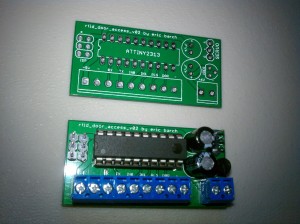Solar Panel Build – More Power!
Posted: January 21, 2012 Filed under: Projects 1 CommentA new solar panel is born – More Power!
As we learned from our feedback, solar cells must all be of the same size/power capacity to hook them in series properly. In the original solar panel we had snapped our third row of cells in half to get them to fit down the remaining glass and make it easy to solder together. That essentially limits the current output of the entire panel because the full size cells are choked by the limited current that can pass through the snapped cells. So we built another panel using all complete cells. It made it take a little longer wiring the cells together since we couldn’t just run down the straight line of them all, but we found that using tabbing wire for everything worked good. If you bend or fold the tabbing wire to make 90 degree angles it made it pretty easy to solder to the next cell.
Laying out the new solar panel
Solar Panel Build
Posted: October 3, 2011 Filed under: Projects 2 CommentsMake sure to read both the Wind Turbine Build and the Solar Panel Build. Then watch The Tech Junkies Episode #9 that documents it all and puts them to the test!
Solar has really come down in price since the last time I looked. We wondered if we could start powering our shop off of solar. A good project would be to see if we can build a small scale solar array which would generate power back to the shop and keep it under $1/watt. This would have to include everything from the solar cells to getting usable power out the other end. So we started searching around.
Wind Turbine Build
Posted: October 3, 2011 Filed under: Projects 12 CommentsMake sure to read both the Wind Turbine Build and the Solar Panel Build. Then watch The Tech Junkies Episode #9 that documents it all and puts them to the test!
For this build we wanted to make a low cost wind turbine that could give us some good usable power at a low dollar-per-watt budget. We started out designing a 7′ 6″ diameter turbine and used a motor that has a max output of 1,100 Watts. Our goal is to make a wind turbine that costs less than $1 per watt to build and operate. This includes the tower, the wind turbine, and the inverter to tie it in to our electrical system. We were pressed for time on this build because we had very high winds forcasted just two days after we started the build. We needed to come up with something quick to get this thing in the air and see what it could do.
RFID Tag Cloning
Posted: September 18, 2011 Filed under: Projects 12 CommentsIn the second half of the RFID TTJ episode we covered how to clone or spoof an existing RFID tag. This was partially to expose the security flaws of RFID, but also because it can be very useful. I’ve stayed in a few apartments now that require an RFID tag to get in and out of the main gate. Sometimes you’ll end up getting only one or two RFID tags for the main gate when you have more people living in the same apartment. It’s also inconvenient if you have friends that come over often and you have to let them into the gate every time.
Almost all of this information and work was put together by Micah Elizabeth Scott over at scanlime.org. We simply experimented with the technology and found what works best for us.
RFID Door Lock
Posted: September 16, 2011 Filed under: Projects 47 CommentsI’ve been a college student for a few years now and one of the first things that I hacked together while staying in a dorm room was an RFID (Radio Frequency Identification) lock. I was always in a rush to get in and out of my room and having a wireless key made it that much easier. The challenging bit was that I needed to be able to attach it to my door without modifying any of the hardware and I also wanted it to be hidden from the outside. My first prototype was pretty rough, but over the past year I’ve refined my design and finished a minimalistic circuit board.
Open Source Robot Controls
Posted: July 22, 2011 Filed under: Projects 64 CommentsI’ve been playing around with some ideas for an Arduino/Netduino robot control system the past few months. I knew that I wanted to be able to control my robots from an Android phone, PC, or any other WiFi enabled device. I also knew that I wanted the system to be small and simplistic, but also powerful and extensible. The reason I went with an Arduino (Ethernet Pro) or a Netduino Plus for the controller was the low cost, ease of programming, and the embedded ethernet port. I coupled the onboard ethernet with a wireless router so that I could connect and transmit data to the robot wirelessly. Here are the results of our first robot build with this system. The robot was affectionately named Mantis.
Robot Project (Mantis) Teaser Video
Posted: July 11, 2011 Filed under: Projects Leave a commentHere it is, folks. Just finished our latest and greatest robot project. We edited together a quick teaser video to show off a bit of what the robot (affectionately named “Mantis”) can do.
You should see a full blown episode in the next day or two of exactly how the control system works and how you can build your own! If you’ll be around the Detroit area at the end of the month, we will be showing off Mantis and a few other robots at Maker Faire Detroit! We will be located in the i3 Detroit hackerspace booth. Hope to see you all there!
Eric
Green Screening in Final Cut Pro X
Posted: July 11, 2011 Filed under: Projects Leave a commentHey all,
I wanted to make a quick video showing off how to do chroma keying (Green Screening) in the latest Final Cut Pro X for anyone who may be unfamiliar with the new version. Enjoy!
Eric
New Android/Arduino App – ipgamepad
Posted: May 4, 2011 Filed under: Projects 6 CommentsJust wanted to post a little update here about the latest project I’ve been working on called ipgamepad. If you’re looking for a video, don’t worry. We’ll be documenting this fully in the next episode.
In a nutshell, ipgamepad is a simple app that runs on any Android device and acts as a virtual gamepad controller that transmits the control data wirelessly. Right now it’s extremely simplistic in nature (just 2 analog sticks), but I have plans to build out a full controller with buttons and switches. My motivation behind building this is for controlling Arduino/Netduino robots over WiFi.
If you’re like me, you probably have a spare wireless router lying around the house and there’s a good chance you’ve got an Android device accessible to you. With those 2 components you’re literally a microcontroller + ethernet interface away from a wireless control system. On the Google Code page, I’ve also provided an Arduino sketch that you can run if you have an Ethernet shield. You can directly control servos or speed controllers from the Arduino, providing a complete robot control system.
If you’re an Android developer and are interested in helping with the project, let me know! I definitely could use the help developing the app and there are a lot of things to improve/implement before I consider the app anywhere near polished.
The video episode will be following soon with a full explanation and robot demo. Enjoy the code until then!
Action Sports Game Timer
Posted: November 19, 2010 Filed under: Projects Leave a commentTimer for airsoft and paintball games that has multiple game modes (defense/attack/capture). Timer must be “diffused” by a player in defense mode, armed/diffused in attack mode, or 2 teams fight over control in capture (king of the hill) mode.
This is currently a work in progress. More details and code coming soon.








